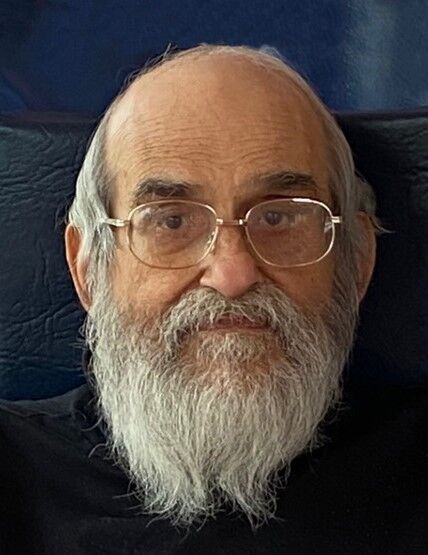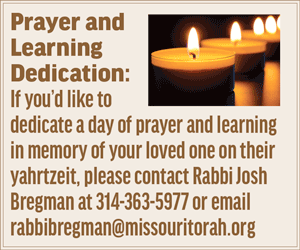Herbert J. Gralnick
Published February 8, 2021
On Saturday, February 6, 2021, thirty-eight days after the passing of his beloved wife Rhoda (z”l), Herbert J. Gralnick died of a broken heart.
Born in St. Louis, Missouri in 1937, Herbert always knew he wanted to be an artist, and devoted his life to his family and the pursuit of this passion.
In 1955 Gralnick began translating his feelings, fantasies and experiences into images – which he described as symbolic metaphors – with the human figure in the center of his visual ideas. He often incorporated Judaic themes into his works, and was inspired by writers, religious leaders and politicians of his generation, many of whom he would write to when he felt particularly strongly about an issue or their actions. A prized possession was his scrapbook of their responses, filled with hand signed letters, autographed photographs, and related memorabilia.
A graduate of University City Senior High School, Herb earned a Bachelor of Fine Arts degree from Washington University in St. Louis, and then completed his Master of Fine Arts degree at the University of Cincinnati and The Art Academy where he was befriended and mentored by renown calligrapher, Dr. John Tcheng. Herb’s initial focus was as a painter and printmaker, but over the decades he became a prolific creator of pen and ink drawings, silkscreens, sculptures, ceramics, and multi-media collages as well.
His art is displayed in over 200 private collections throughout the United States, Canada, England, Israel and Mexico. Pieces can also be found at a dozen universities, several foreign embassies, and the Saint Louis Art Museum (SLAM). Coretta Scott King and the Kennedy Family own works centered around Dr. Martin Luther King, Jr., and brothers John and Robert Kennedy, respectively.
But Herb’s contributions were not limited to the art pieces he produced.
Early in his professional career, Herb worked with Mayor Alfonso Juan Cervantes in bringing the Spanish Pavilion to downtown St. Louis and was responsible for introducing the idea of having students paint the wooden fencing around the construction area in order to bring awareness to the project and beautify the area. He also earned recognition from the City of University City’s mayor, Nathan B. Kaufman, for leading the first Spring Festival Professional Art Exhibit, and was subsequently appointed as a consultant to the Art Committee of the Special Events Planning Committee, overseeing exhibitions and advising city leaders on all matters related to the visual arts.
Certified in Secondary Level and Art Education, Herb taught at Webster University in St. Louis, then accepted an offer to chair the art department at Kalamazoo Valley Community College, moving his family to Portage, Michigan, (where there were no sidewalks and no other Jews.) He was later invited to become Chairman of the Art Department/Artist in Residence at the College of White Plains/Pace University, and Adjunct Professor to Empire State College/State University of New York.
Wherever he taught, Herb introduced innovations and cultivated relationships; colleagues became partners in change, students became lifelong friends, and during Jewish holidays the family dinner table was often enhanced by a diversity of individuals whose varying religious beliefs, cultural origins, and gender identities contributed to rich conversations which fostered open-mindedness and created bridges between seemingly disparate groups.
This tradition of inclusion continued for decades, expanding to encompass his childhood friends, new friends made in later years, relatives, and his children’s peer group, who would gather over food to socialize and celebrate special occasions at Guo Bin Chinese Restaurant.
One of the relationships which was most precious to Herb was with Morton D. “Buster” May, who served as his patron and friend. Herb assisted Buster with repairing and restoring items which were displayed in the 1975 “Ritual Arts of the South Seas” exhibition at SLAM and were later donated to the museum’s permanent Art of the Pacific Islands/Oceanic galleries; he also helped to maintain May’s private art collection, and often served as the curator and catalog writer for exhibits that May sponsored.
Herb retired from teaching in 1974 and returned to St. Louis to work full-time in his studio, but still found other ways to contribute to the “art scene”. He was a writer and art critic for ARTnews Magazine, as well as for St. Louis Magazine, the St. Louis Globe Democrat Newspaper, The St. Louis Jewish Light Newspaper and The Riverfront Times.
Preceded in death by his parents, Mildred and Mitchell Gralnick, and brother, Abram “Abe” Gralnick, Herb’s legacy is reflected in his children Michelle Gralnick, Leslie Gralnick, and Marshall Gralnick, and is carried on by his precious granddaughter, Hannah Rose Gralnick. He is also survived by sister-in-law Angeles “Angie” Gralnick, cousins, nieces and nephews.
The family invites those who wish to share special memories of Herb to email stories and photos to [email protected].
Donations in Herb’s merit may be made to Jewish Family Services, the Saint Louis Art Museum, CARE STL: Center for Animal Rescue and Enrichment, or a charity of one’s choosing.
The family extends their deepest thanks to all the doctors, nurses, health workers, administrative staff, relatives and friends who cared for and about Herb during his lifetime.
A private graveside service will be held. BERGER MEMORIAL SERVICE















